
Designing Point Based Loyalty Programs That Work
In a previous article, we reviewed the way that loyalty programs can help businesses improve sales, increase profits, establish long-term relationships with customers, and encourage them to become advocates for your brand. To achieve these goals, modern loyalty programs are increasing in complexity and using a variety of tools and approaches including gamification, forecasting, and customization as well as incorporating elements of behavioral economics.
It’s an important yet difficult task to build an engaging, memorable, and habit forming loyalty program. It’s also necessary to design it in such a way that the rewards are attractive, experiential, and elicit an emotional response. This is necessary because customers are now bombarded with more potential programs than ever before so making yours stand out from the crowd can be a challenge.
In this article, we will talk about the main steps required to develop a point-based loyalty program, take a closer look at customer types and profiles, and discuss the best ways to engage customers. We’ll also take a look under the hood of point-based loyalty programs to see how rewards calculations work, how they’re performed, and how they affect the customer journey.
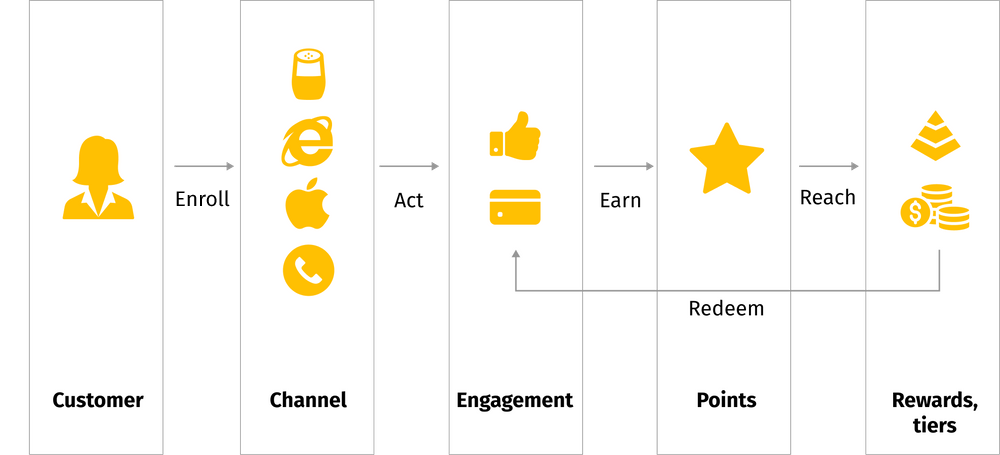
As illustrated above, there are four primary steps involved in a points based program:
- First, companies reach out to their customers to incentivize them to enroll in a loyalty program
- When customers are enrolled, companies motivate the customers to take various actions (make a purchase, refer a friend, or download an app by rewarding them with points)
- Customers collect points to reach certain goals like rewards or higher tiers
- Once goals are reached, customers can redeem their rewards and benefits and use them to make new purchases
The more the customer buys - the more they get in rewards. And the more they are motivated to buy again and again.
Customer types and profiles
What is the best way to turn a regular customer into a loyal one? This is an important question that every retailer should ask themself. The key to answering it is to gain a deeper understanding of your customers. Who are they? What are they looking for? What qualities do they value most in products? What are their interests, habits, and desires? Building customer profiles and learning customer types will help you answer all of these important questions.
The easiest way to describe basic customer types is via a customer loyalty ladder or journey. It shows the evolution of a customer from potential buyer through to business advocate. Let’s take a look.

As we can see above, the first category is a prospective or potential customer. It’s a customer who is potentially interested in buying a product or service and hasn't yet made a decision whether to purchase or not. Usually, such customers are looking for information and comparing offers from multiple sellers. The main goal at this stage is to figure out what information they need such as price, description, quality, etc, and provide that information through the most convenient channel. It's the best time to promote your loyalty program to potential customers and encourage them to enroll and make a purchase. For example, you can offer a discount, points, or free delivery with enrollment and their first purchase.
The next type is a customer or regular customer. As soon as prospects make their first purchases they become customers. They are not loyal to your business yet and can easily switch to another retailer so keeping them shopping with you is a high priority. What tools can be used here? Without doubt, a good loyalty program with great deals and personalized offers will help you stand out!
Moving forward, next is a supporter. Supporters are not only customers who are buying products or services but are also big fans of your business and believe in it. At this stage, they may choose your product over that offered by competitors even if another offer is better, because they are loyal to your business. The best thing you can do to keep them loyal is to provide them even greater rewards and better deals. It is also a good idea to praise their love and help them to show it to everyone by providing small gifts like stickers, t-shirts, or bags.
The final step in the journey is an advocate. These people are not only big fans of your business, they actively promote and advertise it among their families, friends, and colleagues. They talk about your products, post on their social networks, and give you great positive reviews everywhere they can. They play a crucial role in promoting long term brand awareness and generating revenue for the business so its really important to show them how much you value their attitude towards your brand. Provide them with the best deals you can offer, grant them early access to new products or exclusive discounts, or in some cases you can even consider a paid collaboration.
Now that we’ve gone through the categories of customer types, it’s time to ask yourself - who is your ideal customer? Conversely, it’s also important to be able to understand what types of people fall into the prospects category but will likely never make a purchase and hence become a customer. So to help us understand who our ideal customers are, we look to customer profiles.
A carefully built customer profile should provide you all the relevant information about people a retailer wants to convert to become customers:
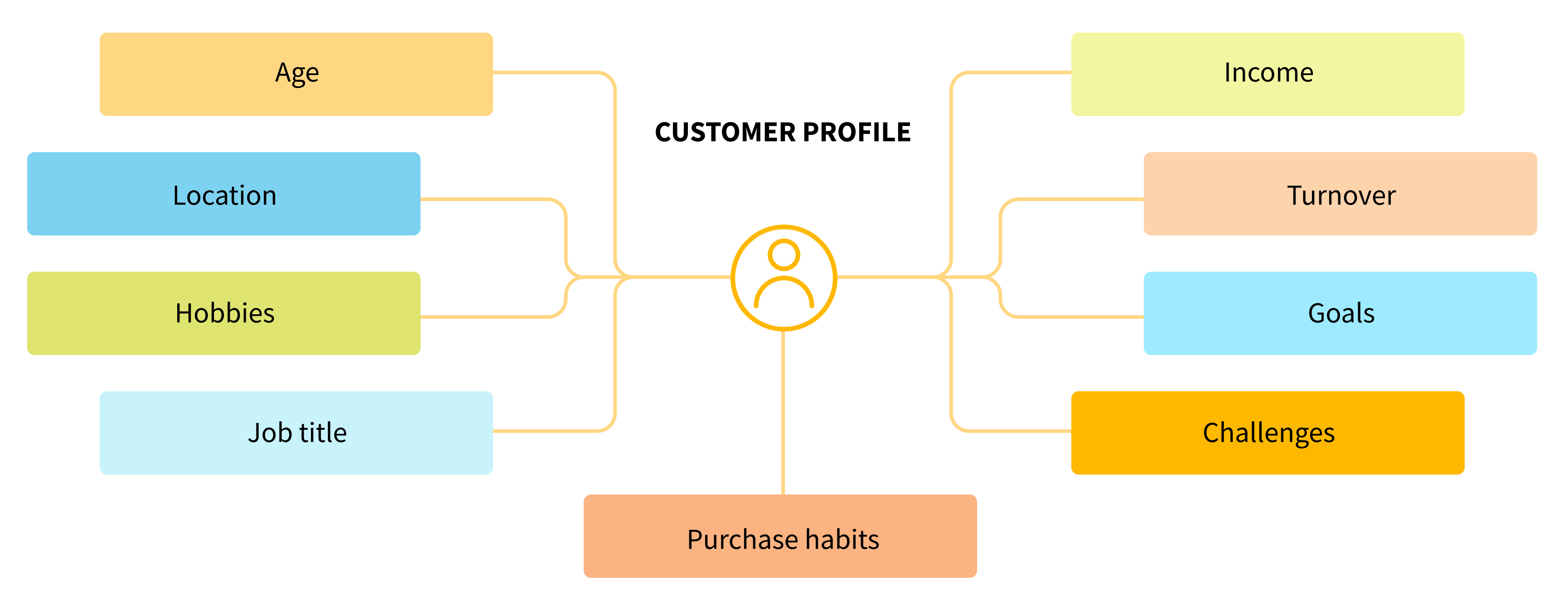
It includes common details they tend to share, such as their:
- Age
- Location
- Hobbies
- Job title
- Income
- Purchasing habits
- Goals or motivations
- Challenges or pain points
There are many benefits that stem from creating customer profiles - it provides a full suite of information about a customer and allows for more rapid changing of targets. It also crucially allows for personalization or customization so that you can offer discounts and gifts that are targeted and meaningful.
A B2B customer profile should include the firmographic data of their targets - such as their company size, employee count, or annual turnover. In the case of B2B customer profiles, it’s better to split it into “B2B vendor/supplier” and “B2B buyer”. This is to account for the fact that B2B buyers can really be split into the company buying the product or service, as well as the user or person actually buying for the company. Therefore it often makes sense to maintain profiles for both the company and the buyer.
Recent research shows that most B2B loyalty programs face the issue of being very company-centric: overly focused on their own story, rather than the preferable customer-centric model that is focused on the customer’s story. Just as with retail customers, for B2B buyers it’s also really important for a B2B vendor to understand their needs, companies, industries, sectors and experiences. As a result, all these parameters should be tracked in the B2B buyer profile.
The most valuable resource used to create customer profiles is data - you should collect all relevant information and make efforts to ensure it is accurate. The marketing team can assist in this area by sharing behavioral information about customers since they are connecting with them on a daily basis.
To get basic info about a customer like age, gender, location, phone number, and email address, a retailer can use a loyalty program enrollment form. It’s a great idea to use web analytics tools to learn customers’ interests and what they’re looking for. Surveys can be used as well since they’re a really good tool for gathering information about customers’ habits and attitudes.
Enrollment channels
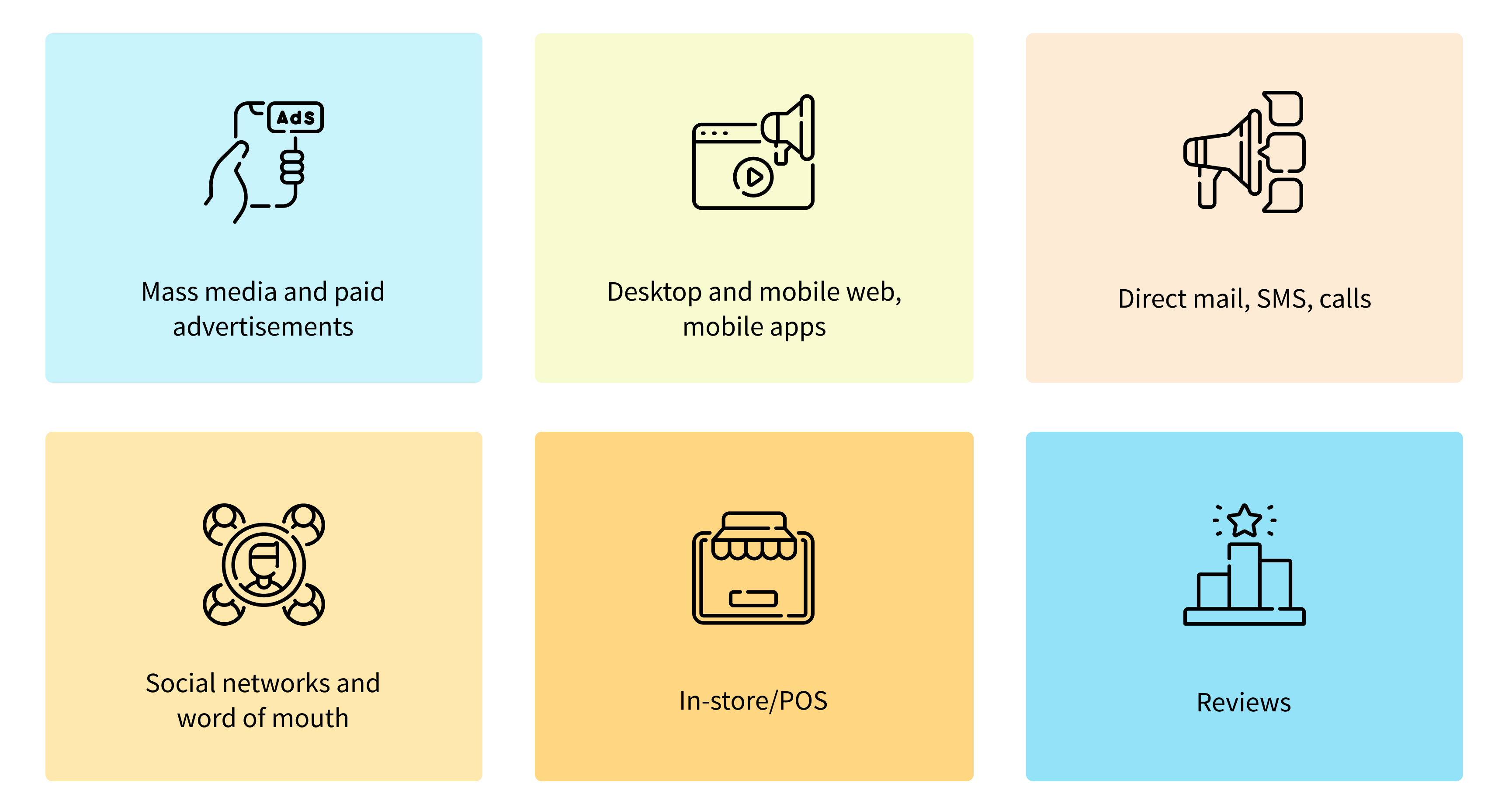
While the main goal of loyalty programs should always be to motivate customers to ultimately lead to bringing in more money for the business, no matter how good your loyalty program is, it will never work if nobody knows about it. Only a well known and well promoted program will work. To help customers learn about all the great benefits a loyalty program can offer, businesses have to reach out to them using different means or channels. Every business can decide what channel works best for them in attracting and enrolling more customers but in most real situations you will find that a multiple channel approach works best.
Let’s highlight the main enrollment channels:
- Mass media and paid advertisements - There is nothing with a larger audience than mass media and if you want as many people as possible to know about you as soon as possible, consider a paid advertisement using mass media channels. You can show your commercials on TV or radio, order a promotional article in a newspaper or magazine, pay popular Youtube vloggers or social network influencers, and many more. The downside is these options are usually very expensive.
- Desktop and mobile web, mobile apps - Got a shiny website or handy-dandy mobile app? Use it to promote yourself. For example, you can use advertising banners on your website or push-notifications on your mobile app.
- Direct mail, SMS, calls - You can use so-called ‘cold’ methods and spam your promos to anyone within reach. This doesn’t always tend to have a high conversion rate however, especially in the case of making annoying calls to people. Or you can use a database of your existing customers, who haven’t yet enrolled in your loyalty program, which usually works much better.
- Social networks and word of mouth - Ensure you have a strong presence on all popular social platforms. These are easy, powerful, and even better - free if you do it yourself. You can alternatively choose to use an SMM team to help you grow your community or pay third-party SMM agencies. Social networks are really useful because they make it easier to spread the word and nothing is easier than hitting a “share” button.
- In-store/POS - You have a physical place where people can come and shop. Great! It is the best place you can promote your loyalty program because most people who come there are already interested in your business. Place advertisements on walls, train your salespersons to talk and promote, or place a tablet or terminal for easy enrollment.
- Reviews - Yes, reviews. Today, we have a lot of websites and apps collecting reviews, like Google and Yelp. It’s not a secret, most people do their research and read these reviews before they buy something or try a new service.
- Partners - You found another business that works great and bundles perfectly with yours, like a washing machine and laundry detergent. So you can offer a collaboration arrangement where you help promote each other.
Types of customer engagement
Customer engagement defines the interaction between a customer and a business - what is offered by the business and chosen by the customer. Customer engagement is all about the quality and quantity of engagements.
The more engaged customers are, the more they can build an emotional connection with a business and will show preference for your business over a competitor. Therefore, retailers should always encourage and reward every interaction between their business and their customers.
What are they most likely to engage with? Hmmmn.. let’s check the most common activities:
SHOP:
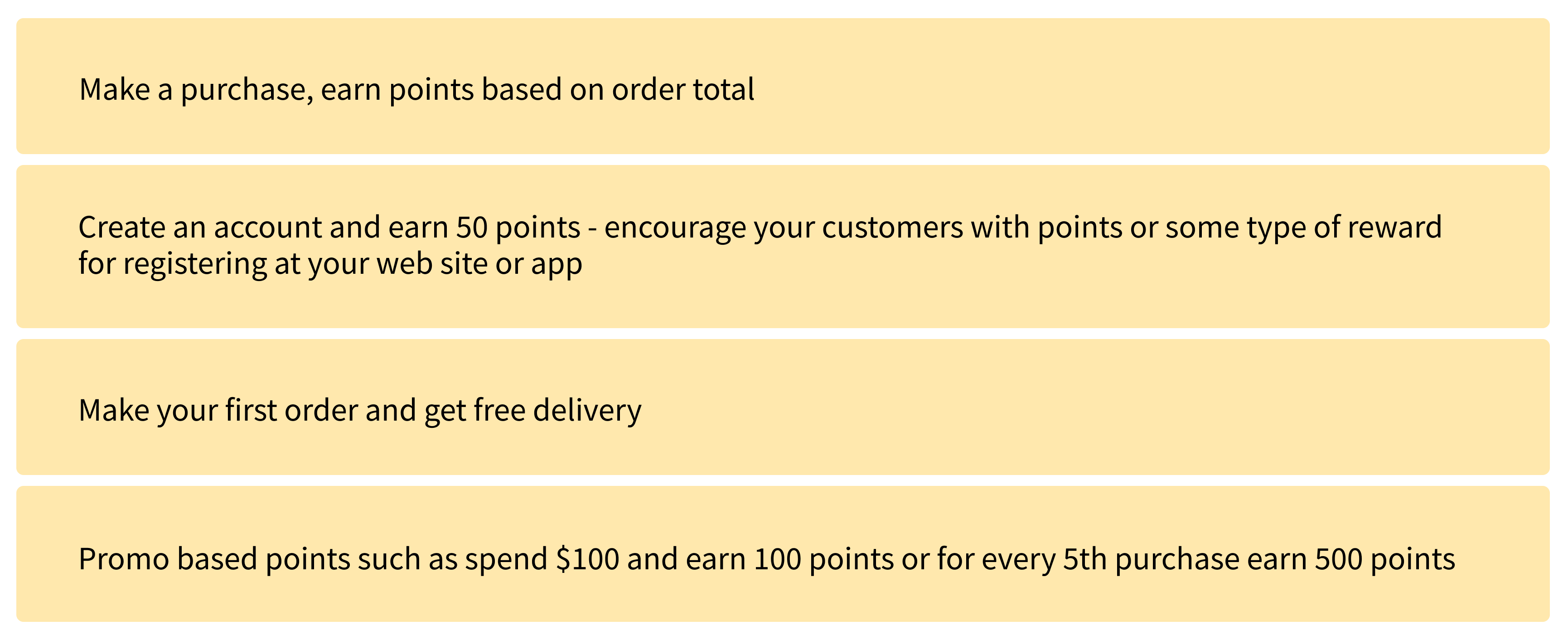
CONNECT:

EXPLORE:
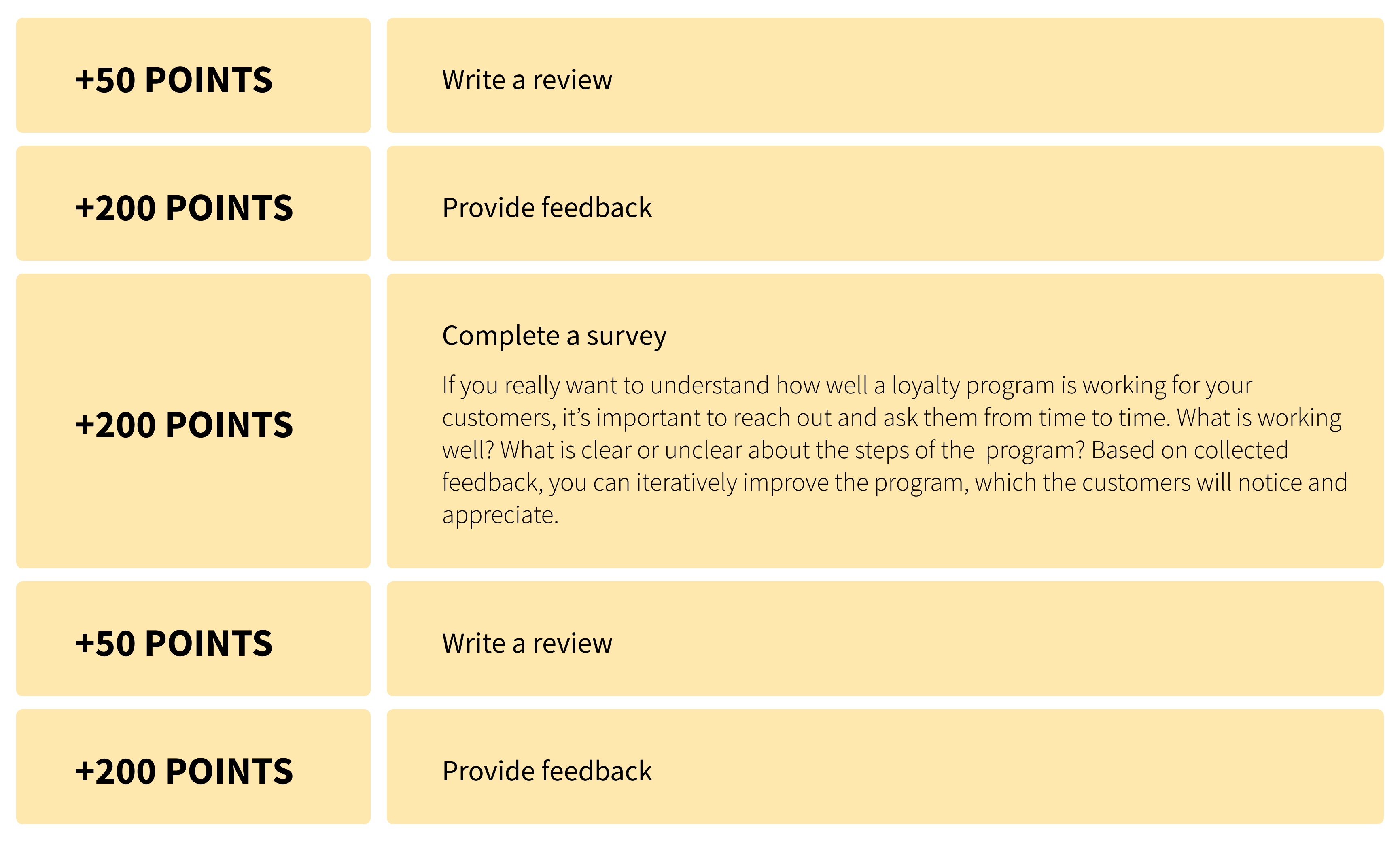
REFER:

The above examples should give you a good idea of the possibilities but remember that you need to work out what works best for your business. What works for one brand might not work as well for another. And always remember that the rewards you choose should be good enough to keep your customers motivated, but not so good that they actually hurt your bottom line.
Points calculation, return policy and points types
It’s well established that loyalty programs stimulate customers to buy more, come back more often, and help build a strong long-term relationship with your business. But the demands and needs of modern customers are becoming more complicated, which is why loyalty programs today often combine elements of different disciplines like behavioral economics, psychology, and the gaming industry. This has led to modern loyalty programs moving away from the basic model of percent off offers and discounts to strategies like personalized interest-based gifts, tier upgrades.
Let’s take a more detailed look at the currencies that loyalty programs operate around. The original and best known currency is “points”, which a customer can receive for different activities and in different stages of communication with a retailer. Such points represent a promise for future purchases or services depending on the business type.
Some example of basic point systems are:
- 1 point for every $1 spent
- 500 points for a $5 reward
- 900 points for a $100 reward
The next evolution in the points calculations is a level or tier. A retailer can add complexity and more interest to a customer by adding tiers.
Examples of rules for points calculations based on tiers include:
- If a customer is on the first tier, then they earn 1 point for every $1 spent
- If a customer is on the second tier, then 2 points is earned for every $1 spent
- If a customer is on the third tier, then they earn 3 points for every $1 spent
If a retailer decides to use tiers based on a certain amount of points earned, then a points threshold needs to be established for each tier.
For example:
- A customer with 0 - 499 points is on the first tier
- A customer with 500 - 1499 points advances to the second tier
- A customer with over 1500 points is elevated to the third tier
Additional rules are often created that govern how long a customer can remain on a tier based on points earned within set time periods.
Examples of such rules include:
- If a customer meets the requirements of a new tier threshold, the new tier will be available to them for a full calendar year
- If the customer doesn't meet the threshold to remain on their current tier, they will be downgraded
- If a customer is on the lowest tier and doesn’t purchase anything for a calendar year, then their points account will be suspended until they make a new purchase
The flow of points calculation logic is simple:
- Customers earn points automatically based on the amount spent on purchases
- The retailer sets how many points are needed in order to qualify for the next tier or to earn a reward
- The points can be converted to rewards once certain levels of points have been earned
Now let’s look at the different kinds of points a retailer can choose to use:
- Base points - earned for every purchase
- Bonus points - earned for a defined list of activities
- Credit points - if a retailer has its own business credit card
- Total points - overall amount of points eligible to be converted to a reward. The following formula can be used to calculate total points:
Total points = base points + bonus points + credit points
More advanced rules can be used for points calculations as well. For example, in addition to the rules mentioned above, a retailer can add some products or services that earn a higher amount of points, such as for every $1 spent on a special category of product such as jeans, this will equal 5 points earned.
Other examples of advanced rules can be related to channels. So a retailer can select a particular channel like the web or in-store so that to earn additional points a customer must purchase a product online or from the store. Retailers can also choose to reward a particular segment of their customers so that those on the second tier or top tier are eligible to earn additional points from a given promo.
How returns affect loyalty programs
At this point it’s worth introducing some more complex elements that need to be considered such as how loyalty points are affected by returns. For example, if it’s known that the average return time for customers at your store is 14 days, then based on that information we can establish a points system that includes two categories for points - active and pending.
Active points mean points that can immediately be converted to rewards. For active points an expiration period should be set up such as one calendar year. Beyond this time the points expire and are zeroed out.
Pending points mean points that will be converted to active points in 14 days.
So in the case where you’re using active and pending categories of points, then a formula for total points will be:
Total points = active points + pending points + bonus points + credits points
You need to establish a clear policy around returns so that it is clear to customers what the effect of returning a purchase or a partial return is on their loyalty points. For every category of points the return policy should be set up and clearly defined. For purchases without any bonuses, keep it simple - return base points proportionally to the purchase return. If a customer returns the full order, deduct all base points added to the account. If a customer returns a partial order, deduct base points proportionally to the base points amount added to the account.
Now let’s check an example with bonus points applied. Let’s say for every $1 spent on jeans you can earn 5 points. In this example we have both base and bonus points. If a pair of jeans costs $30, then 30 base points and 150 bonus points are added to a customer account. Now imagine a customer has bought two pairs of jeans and wants to return one of them. Here we would deduct base points proportionally but what do we do with the bonus points? All loyalty programs are designed to encourage customer loyalty so ideally we should not ever deduct bonus points but that is a decision you will have to make.
Now what if you deduct points and a customer’s points amount becomes negative? Do you really want to display a negative amount to a customer? In this situation it’s again better to be loyal to the customer and just zero out their balance.
Not having a well planned return policy can lead to the loyalty program being exploited. For example a customer can earn more than they’re entitled to by using a promotion and then returning an item in order to increase their points balance.
Cash rewards
Now that we’ve covered using points as the currency of loyalty programs, what about using real money instead? Yes, you can also choose to reward your customers with real money.
The best example of such a rewards system is Kohl’s cash. Kohl's Cash is a coupon that you earn by shopping during a specified time period. It can be redeemed on a future purchase made during a corresponding redemption period. You get $10 worth of Kohl's Cash for every $50 you spend after all discounts are applied and before sales tax.
Building a community
As we are now living in the social media age, it’s becoming increasingly important to build a community around your business. The more ambassadors of your business you have, the quicker your customer base will grow.
Nike has developed a very attractive loyalty program to encourage customers to complete set activities. The program includes multiple aspects to achieve personal sport goals as well as to build a community of customers with similar interests. For this, customers are encouraged by the potential to earn bonus points for completing activities that they like in their personal life. Leveraging these types of activities or community engagement strategies can make a crucial contribution to boosting the brand awareness and longevity of your business.
Rewards options
In the previous section we learned about points, their nature, and how to earn them. Now let’s move on and understand what kinds of rewards are available for the customers. Customers can receive rewards based on points like a $5 reward as a discount, which the customer can then use on their next purchase.
Keeping customers connected to your business is getting more and more difficult and it’s not always enough to offer only $-off or %-off rewards. Every retailer should always remember that rewards work best when they’re unique and memorable. So retailers should be asking themselves what other kinds of rewards can be used to engage customers? What might be the most interesting to them?
 | Gifts | These can be whatever you want, whatever you think will help keep your business in your customer’s minds. A good example of this for a clothing store might be a bag that features your company logo. |
 | Custom rewards | Rewards are tailored for the customer and can’t be obtained anywhere else. This could be a special event or a lottery. |
 | Promotional-based reward | This could be free shipping or free products from your catalog. |
 | Experience-based reward | For valued customers or those that have attained a high tier in the rewards program, you can offer amazing experiences such as a helicopter ride or a winery tour. These types of high end experiences can result in building long term or lifelong loyalty in a customer to your company. |
The final step is to decide how to deliver any earned rewards and how the customers can then use them. There are a couple of options:
- Send the reward directly at your own cost
- Use a 3rd party vendor for the reward delivery
- Send it to the customer with their next purchase
- Provide a reward code, so the customer can redeem it at checkout
To allow a customer to redeem a reward by using a code will save some money on delivery, but physical gifts are more memorable. Retailers will need to make their own decisions like these based on what they think will work best for their business.
Conclusion
This article provided insights into the customer journey, customer profiles, points calculations, types of rewards, and some potential complexities and challenges. It should have provided you with the foundational knowledge needed to plan and develop a loyalty program of your own. But remember that there’s no perfect loyalty program, you should always be looking to refine and improve it.
In the next article we’ll explain how to actually build a loyalty program, what the main components are, and how it can be integrated into your existing ecosystem.
Meanwhile, if you would like to learn how Grid Dynamics can help you create a best-in-class Customer Loyalty Program, don't hesitate to reach out.
